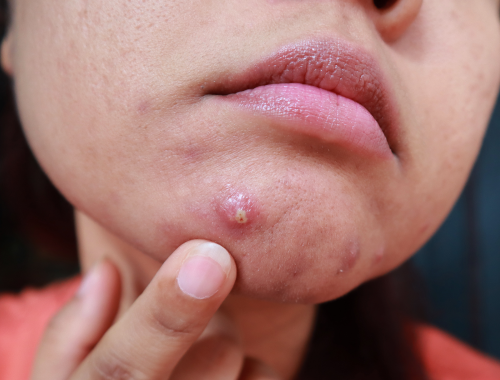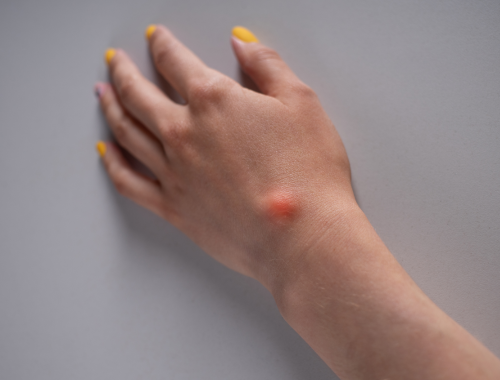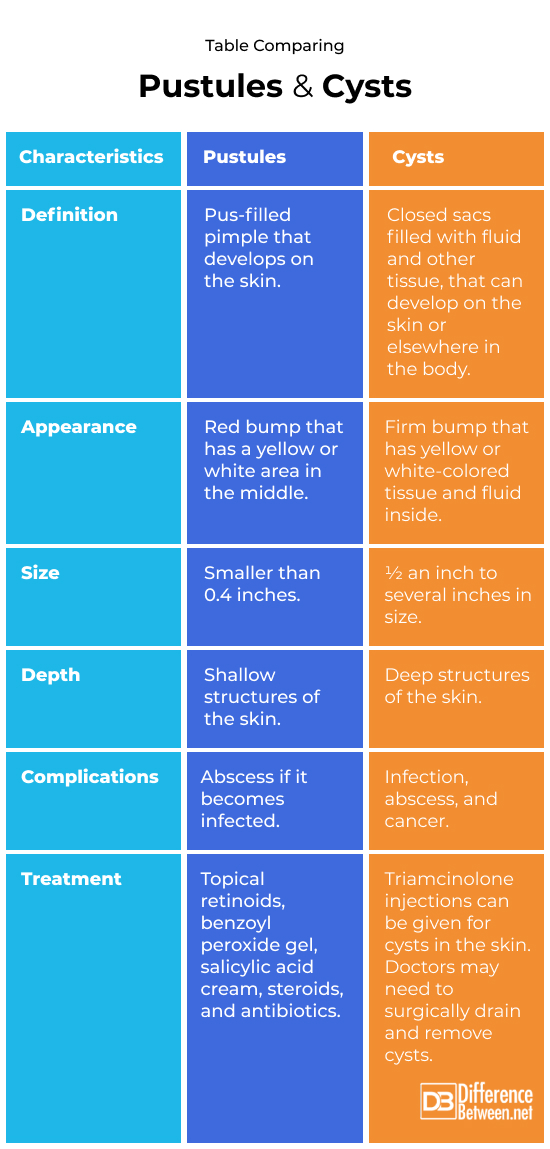Difference Between Pustules and Cysts
Pustules are pimples that become filled with pus. Cysts are larger structures that develop and contain fluid and other material.

What are Pustules?
Definition:
A pustule is a structure that develops from a pimple and is filled with pus (white blood cells).
Causes:
Usually, pustules form on the skin of people who have acne or folliculitis. However, other causes of pustules include allergic reactions or insect bites.
Symptoms and complications:
Pustules develop as small red bumps that contain a white-colored central area. They are shallow and do not penetrate deep into the skin. Pustules are small structures, smaller than 0.4 inches, that are found on the skin. The main complication is a risk of abscess if the pustule is infected but often, pustules are a sign of an inflammatory reaction of the skin.
Diagnosis:
Diagnosis is by the physical appearance of the structures on the skin. A biopsy can be done if there is a concern regarding infection. This is important because pustules can be a sign of a more serious disorder or condition, such as sepsis.
Treatment:
Pustules can be treated using various creams and gels. Topical retinoids, benzoyl peroxide gels, and salicylic acid creams are useful in treating pustules. Prescription-strength steroids and antibiotics may be needed if inflammation is severe and bacterial infection is suspected.

What are Cysts?
Definition:
A cyst is a fairly large structure that contains white or yellow-colored fluid and material and that forms in the skin.
Causes:
A gland in the skin becomes blocked, causing the cyst to form. The condition often occurs when people have acne or a skin injury. Cysts can form elsewhere in the body due to hormonal changes or even parasite infections.
Symptoms and complications:
The signs of a cyst include a bump or nodule developing in the skin that is quite large (greater than ¼ inch in size). The bump often feels hard and may be sore if it is infected. The inside of the bump will contain whitish or yellowish material and fluid. Complications of a cyst in the skin include infection and abscess. A cyst on an organ can become abscessed but can also sometimes become cancerous.
Diagnosis:
Diagnosis of skin cysts is done by a doctor after noting its physical appearance. A biopsy can be done to further examine and confirm diagnose and rule out a tumor. Internal organ cysts are diagnosed through imaging tests such as CT scans.
Treatment
To reduce the inflammation of cysts, an injection of triamcinolone can be given. Cysts on the skin may need surgical drainage and removal, particularly if they are large and painful due to infection. Cysts on internal organs may need to be surgically removed depending on their size and if they are causing problems.
Difference between Pustules and Cysts?
Definition
Pustules are pus-filled pimples that develop on the skin. Cysts are closed sacs filled with fluid and other tissue, that can develop on the skin or elsewhere in the body.
Appearance
A pustule is a red bump and it has a yellow or white area in the middle. A cyst is a firm bump which contains white or yellow material and fluid.
Size
Pustules are small at less than 0.4 inches in size but cysts are much bigger at ½ inch or more.
Depth
A pustule is shallow while a cyst extends deeper in the skin.
Complications
An abscess can form from a pustule if it becomes infected. Cysts can also develop into abscesses or turn cancerous.
Treatment
Topical retinoids, benzoyl peroxide gel, salicylic acid creams, steroids, and antibiotics are used to treat pustules. Triamcinolone injections can be given for cysts in the skin or they may need to be cut out of the skin.
Table comparing Pustules and Cysts

Summary of Pustules Vs. Cysts
- Both pustules and cysts can form in the skin.
- Pustules and cysts can become infected if not treated.
- Cysts can also form elsewhere inside the body.
FAQ
Is a pustule a cyst?
A pustule can develop into a cyst. When this happens, the structure becomes painful and hard.
How do you tell if it’s a cyst or a pimple?
Cysts are larger and contain a sac, while pimples are smaller and do not contain a sac. Usually, a small bump is a pimple, but a bump that is bigger than ½ inch and is firm to the touch is likely a cyst.
How do you treat pustules and cysts?
Pustules and skin cysts can be treated with creams that contain salicylic acid. Benzoyl peroxide gels and antibiotics can also be helpful.
How do you get rid of pustules?
There are treatment options using various creams and ointments that contain salicylic acid and benzoyl peroxide. Retinoids can also help.
Can you pop pustules?
It is inadvisable to pop pustules because you could unintentionally introduce bacteria and cause an infection. It is best to consult a doctor if you are concerned about your pustules.
How long does it take for a pustule to go away?
Pustules may last for about a couple of days to a few weeks.
- Difference Between Rumination and Regurgitation - June 13, 2024
- Difference Between Pyelectasis and Hydronephrosis - June 4, 2024
- Difference Between Cellulitis and Erysipelas - June 1, 2024
Search DifferenceBetween.net :
Leave a Response
References :
[0]Keri, Jonette E. “Acne vulgaris (Acne)”. Merckmanuals. Merck & Co., 2022, https://www.msdmanuals.com/professional/dermatologic-disorders/acne-and-related-disorders/acne-vulgaris#
[1]Mengesha, Yebabe M., and Michelle L. Bennett. "Pustular skin disorders: diagnosis and treatment." American journal of clinical dermatology 3 (2002): 389-400.
[2]Wollina, Uwe, et al. "Epidermoid cysts–a wide spectrum of clinical presentation and successful treatment by surgery: a retrospective 10-year analysis and literature review." Open access Macedonian journal of medical sciences 6.1 (2018): 28.
[3]Image credit: https://www.canva.com/photos/MADnTXsQHzA-woman-removing-pustules-whitehead-acne-from-face-problems-with-acne-and-scar-on-the-female-skin-/
[4]Image credit: https://www.canva.com/photos/MAEoNfFI_CU-ganglion-cyst-on-woman-hand-on-white-background/
